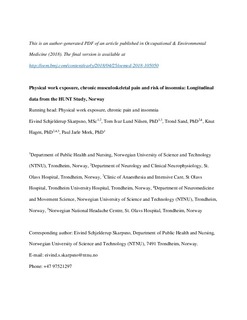| dc.contributor.author | Skarpsno, Eivind S. | |
| dc.contributor.author | Nilsen, Tom Ivar Lund | |
| dc.contributor.author | Sand, Trond | |
| dc.contributor.author | Hagen, Knut | |
| dc.contributor.author | Mork, Paul Jarle | |
| dc.date.accessioned | 2018-05-04T08:22:11Z | |
| dc.date.available | 2018-05-04T08:22:11Z | |
| dc.date.created | 2018-04-24T12:06:19Z | |
| dc.date.issued | 2018 | |
| dc.identifier.issn | 1351-0711 | |
| dc.identifier.uri | http://hdl.handle.net/11250/2497085 | |
| dc.description.abstract | Objectives To prospectively investigate (i) the association of physical work demands and work-related physical fatigue with risk of insomnia symptoms and (ii) if these associations are influenced by chronic musculoskeletal pain.
Methods Prospective study on a working population of 8563 women and 7598 men participating in the Nord-Trøndelag Health Study (Norway) who reported no insomnia at baseline in 1995–1997. Occurrence of insomnia symptoms was assessed at follow-up in 2006–2008. A Poisson regression model was used to calculate adjusted risk ratios (RRs) for insomnia symptoms with 95% CI.
Results Compared with workers without work-related physical fatigue, women and men who reported that they were always fatigued had RRs of insomnia of 2.34 (95% CI 1.72 to 3.18) and 2.47 (95% CI 1.59 to 3.83), respectively. Overall, physical work demands was not associated with risk of insomnia, although men who reported heavy physical work had an RR of 0.67 (95% CI 0.47 to 0.97) compared with men with mostly sedentary work. Compared with the reference group of workers without work-related physical fatigue and no chronic pain, analyses of joint effects showed that women with excessive work-related fatigue had an RR of 4.20 (95% CI 2.95 to 5.98) if they reported chronic pain and an RR of 1.67 (95% CI 0.87 to 3.18) if they did not. Corresponding RRs in men were 3.55 (95% CI 2.11 to 5.98) and 2.13 (95% CI 1.07 to 4.25).
Conclusion These findings suggest that there is an interplay between work-related physical fatigue and musculoskeletal pain that should receive particular attention in the prevention of insomnia in working populations. | nb_NO |
| dc.language.iso | eng | nb_NO |
| dc.publisher | BMJ Publishing Group | nb_NO |
| dc.title | Physical work exposure, chronic musculoskeletal pain and risk of insomnia: longitudinal data from the HUNT study, Norway | nb_NO |
| dc.type | Journal article | nb_NO |
| dc.type | Peer reviewed | nb_NO |
| dc.description.version | acceptedVersion | nb_NO |
| dc.source.journal | Occupational and Environmental Medicine | nb_NO |
| dc.identifier.doi | 10.1136/oemed-2018-105050 | |
| dc.identifier.cristin | 1581238 | |
| dc.description.localcode | © Article author(s) (or their employer(s) unless otherwise stated in the text of the article) 2018. All rights reserved. No commercial use is permitted unless otherwise expressly granted. Published by BMJ Publishing Group for Royal College of Physicians of London, Faculty of Occupational Medicine | nb_NO |
| cristin.unitcode | 194,65,20,0 | |
| cristin.unitcode | 194,65,30,0 | |
| cristin.unitname | Institutt for samfunnsmedisin og sykepleie | |
| cristin.unitname | Institutt for nevromedisin og bevegelsesvitenskap | |
| cristin.ispublished | true | |
| cristin.fulltext | postprint | |
| cristin.qualitycode | 2 | |
